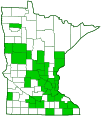white-jawed jumping spider
(Hentzia mitrata)
Conservation • Description • Habitat • Biology • Distribution • Taxonomy
|
|
||||||||||||||
Description |
White-jawed jumping spider is a common, small, typical jumping spider. It occurs in the United States and southern Canada east of the Great Plains. It is common in wooded areas of Minnesota. Adults are found from late spring through summer on vegetation in woodlands and near woodlands. It is most common in the canopy of deciduous and coniferous trees. The female is ⅛″ to 3⁄16″ (2.9 to 4.5 mm) in length and has a ¼″ (6 to 7 mm) legspan. The male is smaller, ⅛″ (3.5 to 4.1 mm) in length. The body is slightly elongated. On the female, the front part of the body (cephalothorax) is longer than wide and somewhat flattened. The plate covering the cephalothorax (carapace) is orangish-brown. It is covered with white hairs and irregularly covered with white scales giving it a mottled appearance. There are four pairs of eyes arranged in what appear to be three rows occupying less than half of the carapace. The first row of four eyes, consisting of the anterior median eyes (AME) and anterior lateral eyes (ALE), is curved backward. The AME are the middle and forward-most pair of these. They are by far the largest of all of the eyes and can be moved. The AME are about twice as large as the ALE. The second row of two eyes are the posterior median eyes (PME). They are very small and are barely or not at all noticeable in most photos. Below each PME there is a pair of close tufts of long black hairs (hair pencils). The third row of eyes is the posterior lateral eyes (PLE). The PLE are set far back on the head and are only slightly wider apart than the first row of four eyes (AME and ALE together). The PME and ALE form a wide rectangle. All of the eyes are ringed with light brown. The narrow plate above the mouth (clypeus) is covered with white hairs. The prominent mouthparts (chelicerae) corresponding to jaws are whitish. There are two sensory appendages (palps) associated with the mouthparts. The palps are yellowish. The chelicerae and palps are covered with long white hairs. The abdomen is grayish-white due to a covering of long white hairs intermixed with short black hairs. In the middle there are two rows of paired dark spots. On the first pair the spots are small and distinctly separated. On the second pair and third pair, the two spots usually merge together, making single large spots. The spots are often indistinct. The legs are translucent and unpigmented. The first pair of legs are the longest. The femur and patella have spatula-shaped hairs on the lower margin. On the male the carapace is orangish-brown with a reddish-brown band on each side that extends around the eyes. In the center it is covered with white hairs and irregularly covered with white scales giving it a mottled appearance. The abdomen is narrower, orangish-brown on top, and grayish white on the sides. |
Size |
Female Body Length: ⅛″ to 3⁄16″ (2.9 to 4.5 mm) Male Body Length: ⅛″ (3.5 to 4.1 mm) Legspan: ¼″ (6 to 7 mm) |
Web |
Jumping spiders do not hunt from webs. |
Similar Species |
Common Hentz jumping spider (Hentzia palmarum) front legs are pigmented, spotted with dark brown. |
Habitat |
In and near woodlands. Three recent studies, (Larrivée & Buddle 2009), (Larrivée & Buddle 2010), and (Aikens & Buddle 2012), determined that Hentzia mitrata has a strong affinity for tree canopies. |
Biology |
Season |
Late spring through summer |
Behavior |
|
Life Cycle |
|
Food |
|
Distribution |
||
|
Sources Richman, D. B. (1989). A revision of the genus Hentzia (Araneae, Salticidae). Journal of Arachnology 17: 285-344. |
|
| 5/18/2025 | ||
Occurrence |
||
Common |
||
Taxonomy |
|
Class |
|
Order |
|
Suborder |
Araneomorphae (Typical Spiders) |
Infraorder |
Entelegynae |
Superfamily |
Salticoidea |
Family |
|
Subfamily |
Salticinae (typical jumping spiders) |
Tribe |
Dendryphantini |
Subtribe |
Dendryphantina |
Genus |
Hentzia (long-jawed jumping spiders) |
Subordinate Taxa |
|
|
|
Synonyms |
|
Anoka mitrata Attus mitratus Attus morigerus Icius mitratus Maevia sulphurea Maevia pallida Wala mitrata |
|
Common Names |
|
golden long-jawed jumping spider white-jawed jumping spider |
|
Glossary
Carapace
The hard, upper (dorsal), shell-like covering (exoskeleton) of the body or at least the thorax of many arthropods and of turtles and tortoises. On crustaceans, it covers the cephalothorax. On spiders, the top of the cephalothorax made from a series of fused sclerites.
Cephalothorax
The front part of the body of various arthropods, composed of the head region and the thoracic area fused together. Eyes, legs, and antennae are attached to this part.
Chelicerae
The pair of stout mouthparts, corresponding to jaws, in arachnids and other arthropods in the subphylum Chelicerata.
Clypeus
On insects, a hardened plate on the face above the upper lip (labrum).
Palp
Short for pedipalp. A segmented, finger-like process of an arthropod; one is attached to each maxilla and two are attached to the labium. They function as sense organs in spiders and insects, and as weapons in scorpions. Plural: palpi or palps.
Visitor Photos |
||
Share your photo of this arachnid. |
||
This button not working for you? |
||
Babette Kis |
||
Hentzia mitrata white-jawed jumping spider Hentzia mitrata, white-jawed jumping spider, photographed at Barnes Prairie Hedgerow, Racine Co., Wisconsin on May 31, 2023. |
||
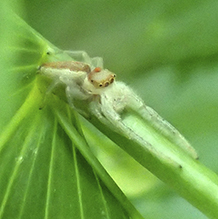 |
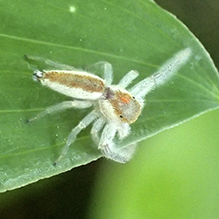 |
|
Alfredo Colon |
||
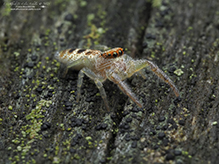 |
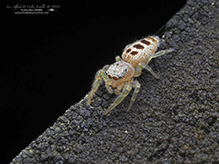 |
|
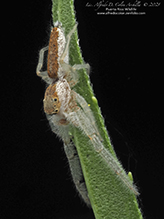 |
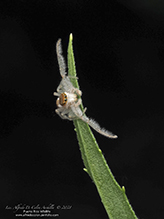 |
|
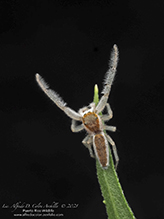 |
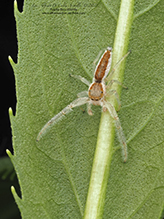 |
|
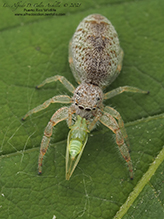 |
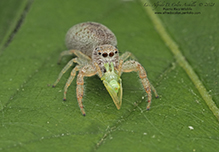 |
|
MinnesotaSeasons.com Photos |
||
|
||
|

Slideshows |
|

Visitor Videos |
||
Share your video of this arachnid. |
||
This button not working for you? |
||
|
Other Videos |
||
Intelligent Jumping Spider-Hentzia Mitrata |
About
Aug 30, 2014 I have seen jumping spiders look through glass and clear plastic before, but this is the first time I caught it on video. I know they aren't as smart as humans, but the jumping spider does have some intelligence working in their little brains. If on a smooth surface, a jumping spider will catch prey and purposely flip on their own back to keep the prey from gaining any traction and having a chance of injuring or killing the jumping spider. |
Hentzia mitrata - Jumping spider |
About
Nov 25, 2010 adult male and subadult female Hentzia mitrata jumping spider - male preys on caddisfly |

Visitor Sightings |
||
Report a sighting of this arachnid. |
||
This button not working for you? |
||
Jenny Wood |
Location: Lebanon, Missouri unfortunately I'm a little bit freaked out by spiders and it was crawling on me so I smacked it I'm sorry I wish I would have taken a picture first but it was identical to this picture |
|
| Babette Kis 5/31/2023 |
Location: Barnes Prairie, Racine Co. Wisconsin Hentzia mitrata, white-jawed jumping spider, photographed at Barnes Prairie Hedgerow, Racine Co., Wisconsin on May 31, 2023. |
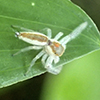 |
| Alfredo Colon 8/24/2022 |
Location: Albany, NY |
 |
| Alfredo Colon 8/2/2022 |
Location: Albany, NY |
 |
| Alfredo Colon 7/8/2021 |
Location: Woodbury, MN |
 |
| Alfredo Colon 7/3/2021 |
Location: Woodbury, MN |
 |
MinnesotaSeasons.com Sightings |
||
|

Created: 7/4/2023 Last Updated: © MinnesotaSeasons.com. All rights reserved. |
